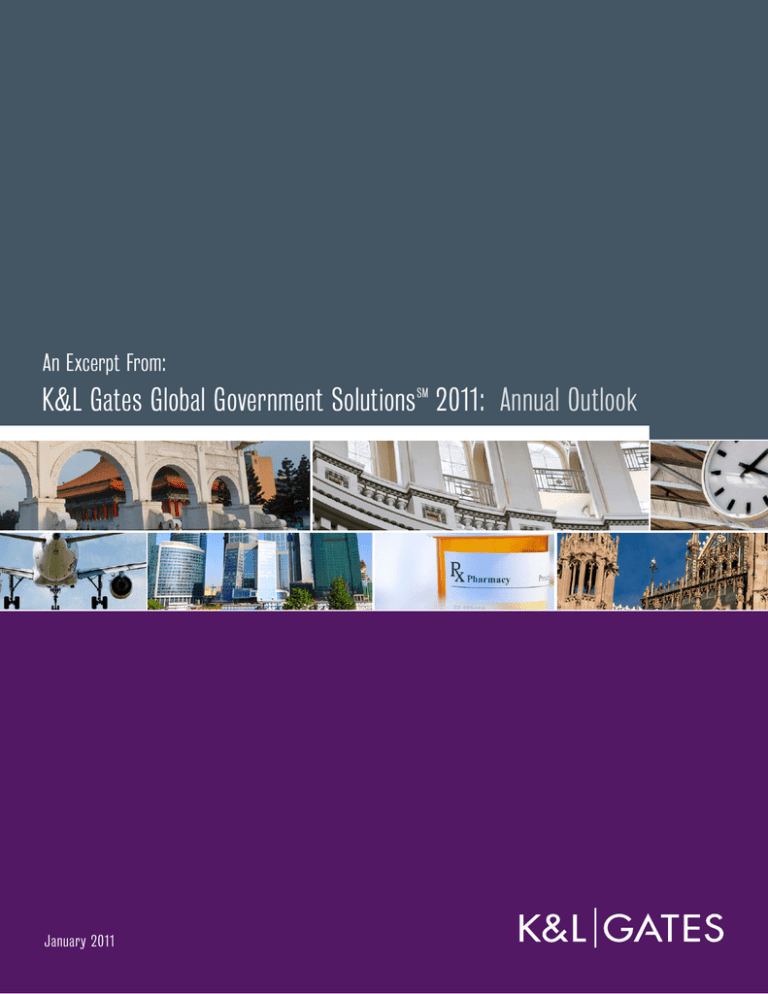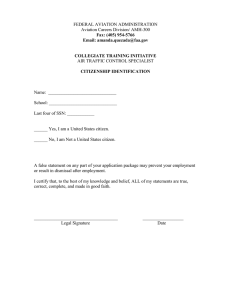
An Excerpt From:
K&L Gates Global Government Solutions SM 2011: Annual Outlook
January 2011
Regulatory
Aviation and International Emissions Trading
In 2008, the European Commission took the major step of including aviation in the
European Union Emissions Trading Scheme (EU ETS) from 2012. This unprecedented
action created controversy between the EU regulator, the aviation industry and states
as to the legality of the extension of the EU ETS to aviation and the best approach to
regulate aviation emissions. The International Civil Aviation Organization (ICAO), the
United Nations agency responsible for international civil aviation, has led key aviation
industry efforts to advocate coordinated actions against climate change.
At the Sixteenth Conference of the
Parties of the United Nations Framework
Convention on Climate Change (COP-16)
held in Cancun from November 29, 2010
to December 10, 2010, the aviation
industry put forward, through ICAO, the
consolidated statement of continuing
ICAO policies and practices related
to environmental protection – climate
change. The main thrusts of the ICAO
submission at Cancun were (i) to reiterate
the determination of ICAO member states
to continue to play a leading role in global
efforts to address climate change by
working through ICAO to limit or reduce
greenhouse gas (GHG) emissions from
international aviation and (ii) to outline
ICAO Assembly Resolution A37-19 of
October 2010 (A37-19). Highlights of
A37-19 include:
• the setting of aspirational global
goals of annual average fuel
efficiency improvement of 2 percent
until 2020 and a fuel efficiency
improvement rate of 2 percent per
annum from 2021 to 2050;
46
• not to attribute specific obligations
to individual states, allowing the
different circumstances, respective
capabilities and contribution of
developing and developed states
to the concentration of aviation
GHG emissions in the atmosphere
to determine how each state may
voluntarily contribute to achieving
the goals;
• encouraging states to submit their
action plans outlining policies,
actions and annual reporting on
aviation CO2 emissions to ICAO,
preferably by the end of June 2012;
• establishing a de minimis threshold
below which states are not expected
to submit action plans towards
achieving the global goals, in order
to accommodate states which have
low aviation activity or difficulty
complying with standards or
recommended practices;
K&L Gates Global Government Solutions SM 2011 Annual Outlook
• developing a framework for market-
based measures in international
aviation in accordance with specific
guiding principles;
• encouraging operators wishing to
take early action to use carbon
offsetting, particularly through the
use of credits generated from the
Clean Development Mechanism
(CDM) of the Kyoto Protocol;
• accelerating the development and
implementation of fuel efficient
routings and procedures to reduce
aviation emissions;
• developing policy actions to
accelerate the appropriate
development, deployment and
use of sustainable alternative fuels
for aviation;
• developing a global CO2 standard
for aircraft emissions by 2013; and
• undertaking a study on the
possible application of the CDM to
international aviation.
A Global Sectoral Approach to
Aviation CO2 Emissions
ICAO advocates a global sectoral
approach to tackle aviation CO2
emissions and considers A37-19 to have
established the first globally harmonized
agreement for a sector to limit CO2
emissions. While A37-19 does establish
a common basis for action to reduce
aviation emissions and the development
of market-based measures, it falls short
of expressly supporting the EU ETS as
a possible building block for a global
aviation emissions trading scheme.
During the ICAO Assembly which
adopted A37-19, the EU stated that
EU ETS legislation made it clear that if
there is agreement at ICAO on global
Regulatory
measures, the EU will consider adapting
the EU ETS. The EU stressed that it was
important for ICAO to develop a global
framework for market-based measures
that facilitated effective action. A future
global framework could well develop
through linking or mutual recognition
of measures developed at a state or
regional level.
Challenge to the EU ETS
Notwithstanding broad support in the
aviation industry for a global emissions
trading scheme and action to reduce
GHG emissions, there has been
considerable resistance from the U.S.
aviation industry to the extension of the
EU ETS to aviation. Indeed, in December
2009, the Air Transport Association
of America and several U.S. airlines
filed an application for judicial review
in the English High Court against the
United Kingdom Secretary of State for
Energy and Climate Change in relation
to the inclusion of international aviation
in the EU ETS. The plaintiffs argue that
the EU has no jurisdiction to regulate
flights flying into and out of the EU and
the unilateral application of the EU
ETS to non-EU carriers is in breach of
international law. In May 2010, the
English High Court referred the matter
to the European Court of Justice for a
preliminary ruling. The key challenges
are that inclusion of international aviation
in the EU ETS:
• breaches Articles 1, 11, 12, 15
and 24 of the Chicago Convention
(on the principal basis that ICAO,
not the European Commission, is
the proper authority to regulate
international aviation);
• breaches Articles 3(4), 7, 11 and
15 of the Open Skies Agreement
between the EU and the United
States (including the granting of
rights, application of laws, charges
and environmental measures);
• contravenes Article 2(2) of the Kyoto
Protocol (the reduction of aviation
GHG emissions should be pursued
through ICAO); and
• breaches customary international
law (including the right of states to
complete and exclusive sovereignty
over their air space).
Some of the arguments against the
challenges are:
• the Chicago Convention was not
drafted to deal with climate change
issues (it came into force in 1947);
• both the United States and the
EU have long-standing histories and
case law exercising extra-territorial
jurisdiction (such as in antitrust
matters);
• the extension of the EU ETS to
aviation is not discriminatory as
it applies to both EU and non-EU
carriers;
• the EU ETS is not a tax, customs duty
or charge;
• the EU ETS does not regulate flights
originating and terminating outside
the EU; and
• reducing GHG emissions is not
the province of any single state
but in the common interests of the
international community.
What This Means for the
Aviation Industry
Pressure will inevitably continue to
be exerted on the aviation industry to
reduce GHG emissions. As a highly
competitive, investment-intensive and
tight-margin sector, the aviation industry
will need carefully designed and
implemented policies and regulations
from governments at international,
regional and domestic levels. The
industry has strong arguments to apply
principles of common but differentiated
responsibility and non-discrimination to
measures that reduce GHG emissions
(as opposed to more risky and
complicated arguments based on the
breach of international law and extraterritoriality outlined above). Policy
makers and regulators will need to
evaluate the nature and needs of the
aviation industry so as to apply realistic
measures while enabling sustainable
growth. It may in reality be difficult to
prevent a rise in absolute emissions in
the short to medium term without posing
a risk to growth in the aviation industry
driven by increasing global economic
activity and social mobility. All actors
should be reminded of the fact that
sustainable development principles
require a balancing of economic, social
and environmental priorities, where no
one priority may outweigh the other to
produce a sustainable outcome.
Christopher Tung (Hong Kong)
christopher.tung@klgates.com
Vanessa C. Edwards (London)
vanessa.edwards@klgates.com
A ruling by the European Court of Justice
is not expected until 2012.
K&L Gates Global Government Solutions SM 2011 Annual Outlook
47
Anchorage
Los Angeles
San Diego
Austin
Miami
Beijing
Berlin
Moscow
San Francisco
Boston
Newark
Seattle
Charlotte
New York
Shanghai
Chicago
Dallas
Orange County
Singapore
Dubai
Palo Alto
Fort Worth
Paris
Spokane/Coeur d’Alene
Frankfurt
Pittsburgh
Taipei
Tokyo
Harrisburg
Portland
Raleigh
Hong Kong
London
Research Triangle Park
Warsaw Washington, D.C.
K&L Gates includes lawyers practicing out of 36 offices located in North America, Europe, Asia and the Middle
East, and represents numerous GLOBAL 500, FORTUNE 100, and FTSE 100 corporations, in addition to growth
and middle market companies, entrepreneurs, capital market participants and public sector entities. For more
information, visit www.klgates.com.
K&L Gates comprises multiple affiliated entities: a limited liability partnership with the full name K&L Gates LLP qualified in Delaware and maintaining offices
throughout the United States, in Berlin and Frankfurt, Germany, in Beijing (K&L Gates LLP Beijing Representative Office), in Dubai, U.A.E., in Shanghai (K&L Gates
LLP Shanghai Representative Office), in Tokyo, and in Singapore; a limited liability partnership (also named K&L Gates LLP) incorporated in England and
maintaining offices in London and Paris; a Taiwan general partnership (K&L Gates) maintaining an office in Taipei; a Hong Kong general partnership (K&L Gates,
Solicitors) maintaining an office in Hong Kong; a Polish limited partnership (K&L Gates Jamka sp.k.) maintaining an office in Warsaw; and a Delaware limited
liability company (K&L Gates Holdings, LLC) maintaining an office in Moscow. K&L Gates maintains appropriate registrations in the jurisdictions in which its offices
are located. A list of the partners or members in each entity is available for inspection at any K&L Gates office.
This publication is for informational purposes and does not contain or convey legal advice. The information herein should not be used or relied upon in regard to
any particular facts or circumstances without first consulting a lawyer.
©2011 K&L Gates LLP. All Rights Reserved.



